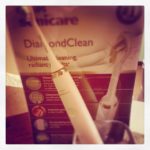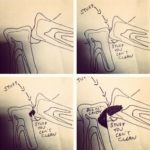
Patients sometimes come to our San Antonio dental clinic complaining that they see a notch on the front surface of their tooth, right at the gum line. The “notch in tooth at gum line” phenomenon is complex on many levels. Sometimes it is sensitive, sometimes it isn’t. Lots of dental patients have them and don’t even notice them. Some patients notice them, but since they don’t hurt they don’t really care what it is.
So what are these things, what causes them, should they be treated, and what are the treatment options? Let’s tackle these four questions.
What Are They?: There’s two possibilities about what these notches you are seeing are are: a carious cervical lesion or a non-carious cervical lesion. Basically, the hole is either caused by dental decay or caused by something else. The first thing that your dentist must determine is if there is decay in the notch. If the notch has dental decay, it’s a cavity. Many patients are familiar with what that is. You might even hear your dentist say “buccal caries” or “facial caries” to describe the surface where the decay is. There are many times, however, when there is no dental decay in this notch. There’s definitely a notch there, but the tooth structure is hard with no evidence of dental decay. As I stated before, We call these non-carious cervical lesions, or NCCLs. (Side note: it is also remotely possible that the notch is a root resorbing, but that’s a whole other topic!)
What Causes Them? The cause of the carious cervical lesion is easy. It’s like any other cavity on any other surface of a tooth. Dental decay is caused by the right mix of poor diet, poor hygiene, and the right type of bacteria living in your mouth.
What causes the non-carious cervical lesion, the little notch in your tooth right at the gum line that doesn’t appear to have dental decay? This is actually a somewhat controversial topic in dentistry. Let me explain. There’s a school of thought with data to back it up that supports that these lesions actually come from toothpaste! The abrasive properties of toothpaste cause these lesions to form on a vulnerable spot on the tooth: the root surface. There’s also a group of dentists and researchers that have evidence to suggest that it comes from aggressive tooth brushing. A number of dentists have research to support the idea that misplaced biting forces are the culprit, or that a habits like clenching and grinding teeth are to blame. Throw diet, GERD, bulimia and poor home care in there as well as possible causes. So how come every patient that does the things mentioned above doesn’t have notches on all of their teeth? How come patients that seem to do none of these things have the notches? How come some of these lesions hurt and some don’t? How come some of these lesions seem to stay the same size for long stretches of time, while others seem to grow rapidly? Whose theory is correct? I don’t have the answers to any of these questions. The evidence seems to suggest that the etiology is multifactorial, meaning that it’s likely a little bit of all of these in various combinations combined with factors and combinations of factors that we don’t fully understand.
Should They Be Treated? Most of the time, the answer is yes, but it is highly dependent on the situation and the patient’s needs and expectations. While the timetable varies for each individual person, it can be said with certainty that existing dental problems get worse over time when left untreated. It doesn’t really matter what it is. Decay in teeth gets larger over time if left untreated. Gum disease and bone loss around teeth gets worse over time when left untreated. If your teeth are crowded or crooked, it will get progressively worse over time if left untreated. The notches on your tooth at the gum line? Whatever is causing them, they are going to get bigger over time if left untreated, guaranteed.
In my opinion, noncarious cervical lesions, these little notches, are one of the most underdiagnosed and undertreated dental problems. I see patients all the time that have been seeing a dentist regularly over the years and they tell me that no other dentist has ever mentioned anything to them about it. Why are dentists and patients ignoring these things?
I have a few ideas why concerning the underdiagnosing and the undertreating. One reason I think it is underdiagnosed is because the cause of the lesion is typically unknown. I think a lot of dentists hesitate to talk about a dental problem with a patient that has an unknown cause. The conversation with the patient is quite difficult. Educating a patient on a topic with a lot of unknown factors is difficult. Dentists don’t want to look stupid when they talk to their patients, and when you start admitting that the cause of something is unknown, I think a fear exists that patients won’t take dentists seriously.
Dentist: You’ve got this little notch on your tooth at the gum line.
Patient: It doesn’t hurt, how did it get there?
Dentist: I’m not sure, blah blah blah theory blah blah dentistry toothbrush toothpaste bruxism abfraction….
Patient: Zzzzzzzz……
Dentist: So do you want to fill it or get a graft or something?
Patient: Nah, it’s not bothering me, I’ll just leave it alone. I’ll wait until it bothers me. Get back to me when you know what you’re talking about…
The other reason I think the lesion is underdiagnosed is that many dentists, myself included, have treated one of these lesions incorrectly and the outcome was not successful. Like most dentists, I like to send my patients out the door in better shape than when they came in the door. It’s a basic principle I like to keep at the forefront of my mind. Let’s say a patient comes in the door with a small notch right at the gum line. The tooth isn’t bothering them and they didn’t even notice they had it. I propose we do a white composite restoration on the tooth. We do it. The patient goes out and eats some ice cream a few days later and the tooth hurts! The tooth never hurt before, and now it does. A year passes, and the filling falls out. Great job, dentist! No dentist wants to be in this position with a patient, so ignoring the problem happens more than it should.
There are two reasons, in my opinion, that the lesion is often undertreated. The first, obviously, is because it is underdiagnosed! Secondly, most of the time the lesions are of little cosmetic concern to the patient and cause little to no pain or sensitivity. Basically, the dentist diagnoses the problem, but the patient fails to place any value into a treatment solution. It is also possible that the dentist and staff didn’t adequately communicate the need for treatment, so the patient doesn’t feel any urgency about it.
Whatever. The facts still remain. The lesions will get worse over time if left untreated.
What Are The Treatment Options?
The treatment option of choice depends on many factors that only a perceptive and conscientious dentist can properly analyze. The overall health of the patient, the patient’s desires and expectations, if the tooth is asymptomatic or not, how big the notch is, the quality of the gum tissue around the tooth in question, the quality of the bone around the tooth in question, the overall health of that tooth, the level of compliance of the patient, the dental caries risk level of the patient, whether or not there is decay in the lesion, the patient’s overall dental health -these are just a few factors off the top of my head that go into selecting the right treatment! You can see how complex the dentist’s job is in determining what the best treatment choices for the patient are. Here’s a somewhat comprehensive list of treatment options that will come up, depending on the situation.
Extracting the tooth -sometimes the notch is just too big and has compromised too much of the crown and root structure of the tooth that no surgical or restorative options to save the tooth are prudent.
Do nothing -sometimes the patient’s dentition is so severely compromised, no predictable treatment options exist for the problem at hand, and the patient isn’t healthy enough or willing to explore any treatment options, including extraction. As a general rule, dentistry should only be done if there’s reason to believe it is going to improve a patient’s quality of life. If the answer to that question is in doubt, it might be best to let it be. I take dentistry very seriously, but I always remember, a tooth is just a tooth. I treat people, not teeth.
Fluoride Varnish -if do nothing/extract one day is the plan of choice, and the notch is occasionally sensitive, fluoride varnish can be the way to go to decrease sensitivity. Using a desensitizing toothpaste, professional application of fluoride varnish, and avoiding the types of foods or drinks that make the lesion hurt can be an effective way to manage the situation. If treatment is intended but needs to be delayed for some reason, this should also be considered a short term way to go.
Fill It -So this is the climactic moment of the article, the whole reason I decided to write this blog post! Filling it with a direct composite white filling restoration is an option that’s on the table, but in most cases it is the wrong option! Don’t get me wrong, it’s a viable option and the correct option in many, many cases. The problem is, many restorative dentists consider this option to be option #1, when in fact, I’m arguing, that it should frequently be option #2. Many patients that don’t know anything about the next point I’m going to make ask dentists to fill these notches. See a hole, fill it, that’s what dentistry is, right? Dentists want to make their patients happy, so the hole gets filled.
Graft it -Option #1. If grafting over the notch is an option, this should be considered the primary treatment of choice. If that’s not an option for any number of reasons, then filling it is back on the table. Sometimes a combination of filling and grafting over it is employed. There are a few different types of grafts: connective tissue graft, free gingival graft, pedicle graft, just to name a few. They are all similar in principle. A graft is when a piece of tissue is taken from a donor site in the patient’s mouth and used to cover up the surface of the tooth where the gums have receded and the notch exists. If the case meets all of the criteria for success, the results can be spectacular and long lasting.
The graft has three big advantages over a filling. First, the physical and chemical properties of the filling material and bonding agent can lead to long term sensitivity when placed on the root of a tooth. A graft won’t cause sensitivity. As a matter of fact, if the tooth was sensitive before the graft, covering it up with the graft usually makes the sensitivity go away over time. Second, the bonding materials used to place fillings don’t work well with root surfaces of teeth. It’s also difficult to create any kind of mechanical retention in this part of the tooth with a filling. That’s a long winded way of saying that fillings placed here typically fall out. A connective tissue graft won’t fall out.
The third reason a graft is better is complex, but bear with me. You’ve come this far! As I explained earlier in great detail, no one’s really sure exactly what factors or combination of factors causes these lesions. Fixing a problem when you truly don’t know the cause can be tricky. Let’s suppose that aggressive tooth brushing and extremely abrasive toothpaste are the reason a particular patient has the lesion. Unless the patient changes their brushing habits, they will likely just brush the filling out over time. Let’s suppose there is something wrong with their bite, and that’s the cause. If you don’t fix the bite with orthodontics or some other adjustment, the filling is likely going to fall out one day. If anyone thinks that a dental restoration can somehow ever be as strong or stronger than a natural tooth or tooth structure that used to be there, they are wrong! The beauty of placing a connective tissue graft, when indicated, over these lesions is that the problem is solved regardless of what the etiology may be. The reason it works, in a nutshell, is that a graft such as a connective tissue graft is stronger than the gum tissue that was originally there that receded away.
In summary, a notch in your tooth a the gum line is a condition that can be predictably treated when it is small, unpredictably treated when larger, and has the potential to render a tooth hopeless or not fixable if left untreated. The cause of the lesion is often unknown and the treatment choices and considerations are complex and confusing. Patients and dentists too often ignore the problem, and patient’s don’t benefit when the problem is ignored.
If you have the type of notches I’m describing on your teeth at your gum line, see your general dentist or periodontist to discuss your treatment options. If you’re in San Antonio, Texas and would like a dentist’s opinion, call my practice today. My wife and I are practicing San Antonio Dentists’s and would be happy to help you and advise you on your concerns.


